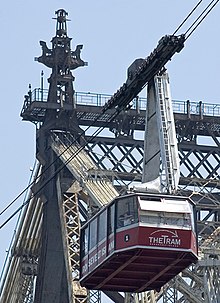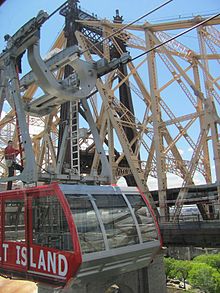Roosevelt Island Tramway
The Roosevelt Island Tramway is a cable car in New York City ( USA ), it connects Roosevelt Island with Manhattan . It is the oldest of originally only three (now two remaining) urban aerial cable cars in North America that are used for local public transport . The cable car was built in 1976 by the Swiss company Von Roll . In 2010 it was replaced by a completely new cable car system built by Poma .
history
Originally, Welfare Island was home to penal and hospital facilities that were relocated over time. An elevator system from the Queensboro Bridge down to the island was used for development, which was replaced in 1955 by a lifting bridge between the island and Long Island City in Queens . In 1968 it was decided to convert the island into a practically traffic-free residential area; From 1969 onwards, building activity began. The elevator system was dismantled in 1970; In 1973 the island was renamed Roosevelt Island .
Construction of the promised subway line under the East River through which the New York Subway was supposed to connect the island was delayed while the first residential buildings neared completion. In order to open up Roosevelt Island from Manhattan, the decision was made to use a cable car as a temporary transport solution due to the short construction time.
The first residential complex on Roosevelt Island opened in 1975, and in 1976 another three residential buildings followed; In the same year, the aerial cableway, built north parallel to the Queensboro Bridge, was finally opened. As the construction of the subway continued to be delayed, "The Tram" became a permanent feature. When the subway finally opened on October 29, 1989, the cable car was far too popular to be shut down, so it was retained - primarily as a tourist attraction.
description
The Manhattan terminal is located at the intersection of 2nd Avenue and E 60th Street and is directly in front of the Queensboro Bridge Plaza ; the nearest subway station is Lexington Avenue-59th Street . It is a one-story tower construction as the cabins must immediately cross the traffic. On Roosevelt Island, the terminal is practically at ground level on Main Street , at the southern end of the island and immediately north of the Queensboro Bridge ( 40 ° 45 ′ 26.8 ″ N , 73 ° 57 ′ 19.6 ″ W ) which spans the East River and island spanned; access to the only subway station deep under the island is a little further north on Main Street .
The cable car is 945 m long and has three up to 76 m high cable car supports to the shipping traffic on the East River to cross, they bring to the required height and the traffic on an exit ramp of the Queensboro Bridge. Since the terminal in Manhattan is next to E 60th St., but the cable car has to use the airspace above this street, it cannot run parallel to the Queensboro Bridge, but only at a very acute angle. Because of the tight space, the first pillar in Manhattan occupies part of a lane of E 60th St., the middle pillar is an asymmetrical construction above this street.
The cable car has been operated by the state-owned RIOC - Roosevelt Island Operating Corporation since 1984 .
The cable car has carried over 30 million passengers since its inception. Although it is not part of the Metropolitan Transit Authority , the journey can be paid for with what is known as the MetroCard . A one-way trip costs the same as a ride on the subway.
Original aerial tramway
The original cable car, which went into operation in 1976, was a classic aerial tramway with two cabins for 125 people each (plus 1 cabin attendant), each traveling on two carrying ropes and by a pull rope at a maximum speed of 8.33 m / s (around 30 km / h) were dragged back and forth between the terminals. A trip took about four and a half minutes, the maximum capacity was 1,600 people per hour. Another rope ran over the suspension and pulling ropes, into which the service and rescue cages could be hung in order to evacuate the passengers in an emergency.
Due to power outages, there was a longer standstill on September 2, 2005 and an hourly standstill on April 18, 2006; the passengers were brought to safety with rescue baskets. Thereafter, operations were suspended until September 1, 2006 in order to overhaul the cable car's electrical systems.
On March 1, 2010, after more than 33 years, the original aerial tramway was finally stopped in order to install a new building.
New broad gauge railway
The new cable car , built by Poma and opened on November 30, 2010, is an atypical combination of two independently operating, parallel, single-lane aerial tramway systems, each with a cabin based on the models of the Funifor and the Vanoise Express . The two cabins for 110 (+1) people are 7.60 m long, 3.82 m wide and hang between two supporting cables that are 4.20 m apart. The cabins can therefore still travel in strong winds and, since they hardly sway, enter the stations at relatively high speed. On the second day, the new cable car was able to prove its stability at wind speeds of 20 m / s (around 80 km / h). Each cabin has its own pull rope, which is returned above the cable car and driven by its own motor. Each cabin attendant controls his cabin independently and regardless of whether the other cabin is already ready to drive or has been shut down due to a lack of passengers or for maintenance. The dispatcher in the valley station, known from the classic aerial tramways, is no longer there, the control center that is still in place is usually empty. Although the new cabins are smaller than the old ones, the conveying capacity has increased significantly in practice. The cabins have two bench seats for a total of 16 people, lighting and video surveillance that are powered by batteries that are automatically charged when you are in the stations.
The 56 mm thick suspension ropes and the 48 mm thick pull ropes were supplied by the Swiss company Fatzer . The suspension ropes have a fiberglass core for data transmission. They are firmly anchored on both sides. The tensioning devices for the pull cables and the drives are located on Roosevelt Island. In addition to the drive motors, there are a number of auxiliary and emergency motors as well as emergency diesel generators.
When the new cable car was built, the buildings and supports could be reused. The supports only had to be reinforced slightly and new heads for the wide tracks had to be provided. An elevator was installed in the Manhattan terminal so that the cable car can also be used with a wheelchair. For 2011 it is planned to design the terminals in an architecturally more appealing way.
For the first five years, the cable car is operated by Leitner-Poma of America for the RIOC.
Media presence
- cinemamovies
- Nighthawks (1981) with Sylvester Stallone
- In City Slickers (1991) the main character Mitch Robbins ( Billy Crystal ) drives her to work.
- Mathilda, played by Natalie Portman , takes the cable car in the film Léon - The Professional (1994).
- Spider-Man (2002)
- In the horror film Dark Water (2005).
- TV
- In an episode of the television series CSI: NY , a murder takes place in the cabin.
- In an episode of the television series White Collar , the main actor makes a daring jump from a gondola roof onto that of the oncoming gondola while driving
- A series of Future Without People shows what happens to the building after a fictional disappearance of mankind and how it collapses 100 years later.
- In an episode of the television series Younger , Kelsey has sex in one of the gondolas with a man who lives on Roosevelt Island.
- Video game
- A replica of the cable car can be seen in the video game Grand Theft Auto IV . The gondolas can be entered in the game and the player can ride along.
Web links
- Website of the Roosevelt Island Operating Corporation
- Roosevelt Island Tramway at nycsubway.org (Eng.)
- Technical data for the cable car on cable car technology
- Roosevelt Island Tramway Detailed description with numerous photos on Remontées Méchaniques (French)
- TPH RooseveltIsland NY video from PomaHighlights on YouTube (3:34)
Remarks
- ↑ Horizontal length: 945 m, inclined length over the supports: 960 m.
Coordinates: 40 ° 45 ′ 26.5 " N , 73 ° 57 ′ 15.3" W.




